Online form builder is a tool used for creating, distributing, and managing online forms. It also has data extraction capabilities for collecting and storing form responses.
A website should include necessary forms such as contact, user registration, feedback, and newsletter sign-up forms. The challenge lies in finding a free form builder that can assist in creating and managing these forms efficiently.
Geekflare researched and included the best free form builders, which are customizable, fast, and have advanced features like conditional logic, integrations, and AI capabilities. The selection factors include ease of use, pricing, support, reputation, and integration capabilities with other business tools.
- 1. Google Forms – Best for Seamless Google Workspace Integration
- 2. Tally – Best for Simplicity, No-Frills Form Building
- 3. Typeform – Best for Interactive and Engaging Forms
- 4. Jotform – Best for Customization and Advanced Features
- 5. Cognito Form – Best for Complex Logic and Payment Integration
- 6. Zoho Forms – Best for CRM Integration in the Zoho Ecosystem
- 7. Wufoo – Best for Quick Forms with a Variety of Templates
- 8. 123FormBuilder – Best for Versatile Form Building and Data Collection
- 9. Microsoft Forms – Best for Office 365 Users with Real-Time Collaboration
- 10. Formsite – Best for Secure Data Handling and Complex Form Structures
- Show less
You can trust Geekflare
Imagine the satisfaction of finding just what you needed. We understand that feeling, too, so we go to great lengths to evaluate freemium, subscribe to the premium plan if required, have a cup of coffee, and test the products to provide unbiased reviews! While we may earn affiliate commissions, our primary focus remains steadfast: delivering unbiased editorial insights, and in-depth reviews. See how we test.
1. Google Forms
Best for Seamless Google Workspace Integration
Google Forms is a user-friendly online form builder tool, especially suitable for those familiar with Google products.
Google Forms offers various form templates for different purposes, such as event registrations, party invites, feedback, assessments, and worksheets. If the ready-made templates do not meet your needs, you can easily create custom forms using the form builder.
Google Form Builder has a drag-and-drop interface and offers various customization options for adding questions, images, text content, and changing colors. It also has live-saving features like real-time previews, redo, and undo functions.
Google Forms is widely used for surveys to manage, analyze, and visualize data in real-time. It provides summarized analytics, real-time alerts, and automatic data collection to Google Sheets.
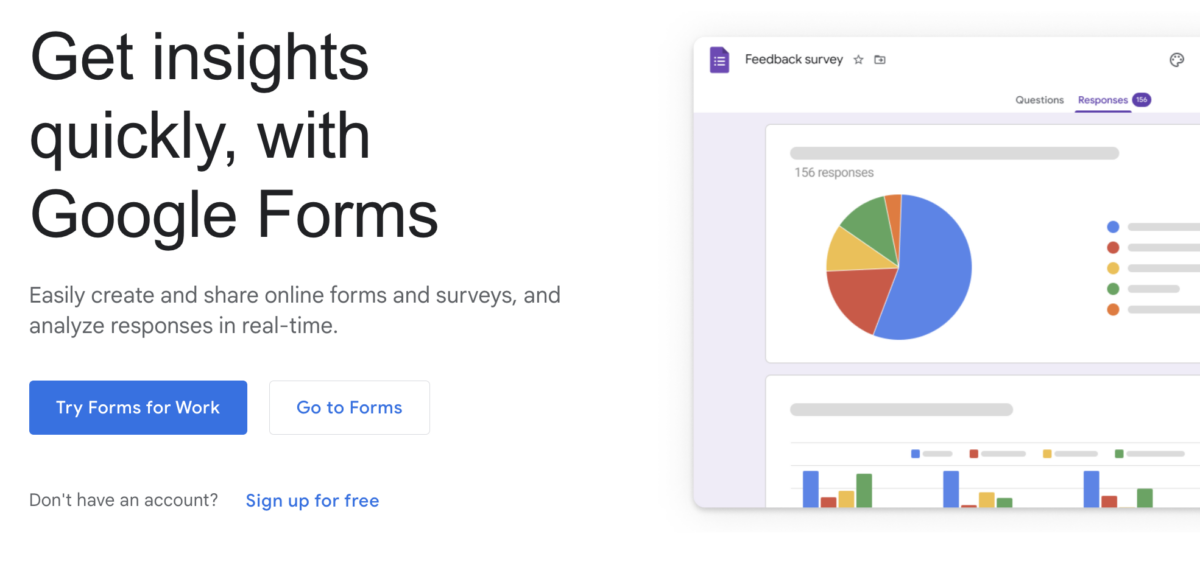
Google Forms Pros
Beginner-friendly interface with a minimal learning curve
Seamlessly integrates with Google’s app ecosystem
Access to add-ons from Google Marketplace
Offers collaborative editing
Google Forms Cons
Having a working Google account is a prerequisite
Limited to basic templates and customization options
Google Forms Pricing
| Plan | Key Features | Pricing |
|---|---|---|
| Personal | Conditional logic, real-time collaboration, pre-build form templates, and 15 GB storage space | Free |
| Business Standard | Group-based security policy controls, 2 TB storage, custom business email, centralized administration, Integration with Google Workspace, and 24/7 online support | $12/month |
2. Tally
Best for Simplicity, No-Frills Form Building
Tally is a no-code online form builder with an intuitive interface. It allows you to create professional forms and surveys quickly. With over 50 customizable templates, it caters to various needs, such as collecting customer feedback, conducting market research, creating assessment forms, collecting registrations, etc.
Tally offers advanced features such as conditional logic, answer pipes, and auto-populated fields to help create dynamic and personalized forms for respondents. It also allows for the use of custom CSS files to customize the design of the forms.
Tally offers integration with popular tools like Google Analytics, Mailchimp, and Slack, as well as platforms like Notion, Zapier, and Google Sheets for efficient workflow and task automation.

Tally Pros
Supports reCAPTCHA to protect your forms from spam and bots
Access to advanced features, unlike Google Forms
Captures unfinished form responses
Tally Cons
Tally’s free plan puts a 10MB cap on the file upload limit.
Forms created using the free plan contain Tally’s watermark.
Tally Pricing
| Plan | Key Features | Pricing |
|---|---|---|
| Free | Unlimited forms, Zapier integration, email notifications, form logic, collect payments, and 20+ language support | Free |
| Tally Pro | Form analytics, webhooks, conditional logic, custom domains, 24/7 customer support, customizable email notifications, and custom CSS | $29/month |
3. Typeform
Best for Interactive and Engaging Forms
Typeform is a free online form creator with eye-catching visuals and appealing form designs that encourage conversion. It offers over 3000+ ready-to-use interactive form templates for marketers, product managers, customer success executives, and HRs.
Typeform offers over 20 different question types and fields, allowing you to build forms tailored to your specific needs. From multiple-choice questions to file uploads, you have plenty of options.
With Typeform, you can easily add your company’s logo, colors, and styles to your forms, ensuring a consistent branding experience for your respondents.
With Typeform’s AI capabilities, you can optimize your forms, automate workflows, and receive data-driven recommendations on how to improve your forms for better results. It easily integrates with your existing workflows and apps, such as Zapier, Calendly, Google Analytics, and CRMs like HubSpot.
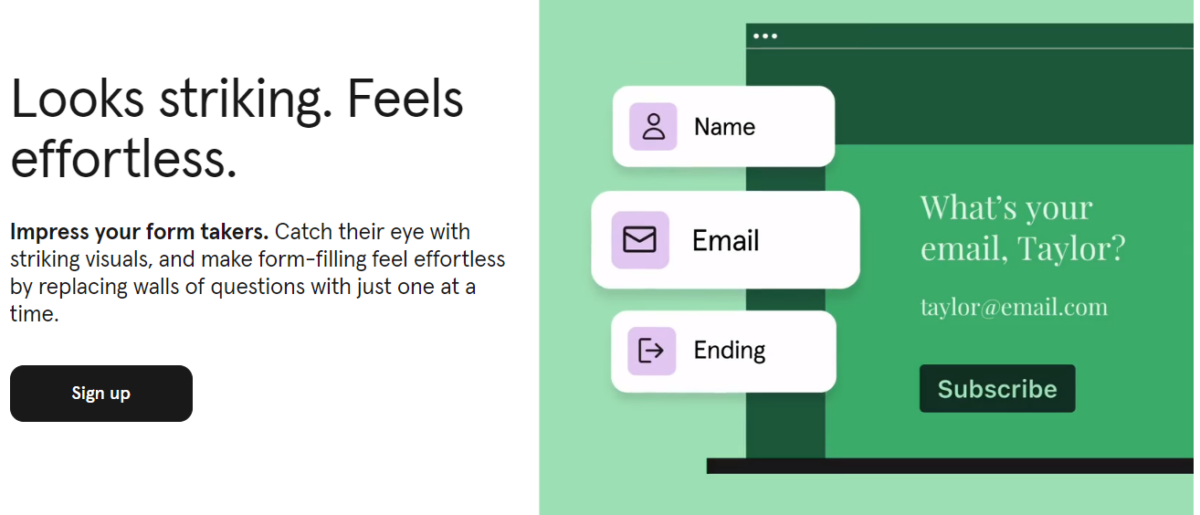
Typeform Pros
Design unlimited forms for free.
GDPR and HIPAA compliance
Offers interactive widgets and elements
Typeform Cons
Overloaded features and functionalities, giving it a steep learning curve.
Lacks the option to present all questions in a single view.
Typeform Pricing
| Plan | Key Features | Pricing |
|---|---|---|
| Free forever | Hidden fields, logic jumps, Zapier, Slack, and other 20+ integrations | Free |
| Basic | Unlimited forms, 500+ integrations with Zapier, accept online payments, and custom meta descriptions | $25/month |
| Plus | Custom subdomains, brand kits, premium themes, API access, email notifications, webhooks, and advanced embed options | $50/month |
| Business | Priority support, conversion tracking, payment acceptance, logic jumps, Integration with 120+ apps, and custom URL creation | $83/month |
| Enterprise | VIP support & dedicated manager, GDPR and HIPAA compliance features, API access, and custom domains & branding | Contact for quote |
4. Jotform
Best for Customization and Advanced Features
Jotform offers a feature-rich online form builder. It provides over 10k+ free templates and three different editors to customize those templates.
Jotform visual editor allows for the customization of themes with brand logos, fonts, and colors. It offers a marketplace with design themes and widgets for building forms, making it easy to create professional-looking forms without design experience.
Jotform offers integrations with popular email service providers, CRM systems, and various data storage units, allowing users to easily transfer and store form responses in their preferred platform.
Jotform provides real-time push notifications on mobile devices, allowing users to receive instant alerts when someone responds to their form, enabling quick action on customer feedback or inquiries.
Jotform integrates with various payment services, such as Paypal, Stripe, Apple Pay, and Google Pay, to allow users to sell products, receive online fees, and collect donations directly through forms.
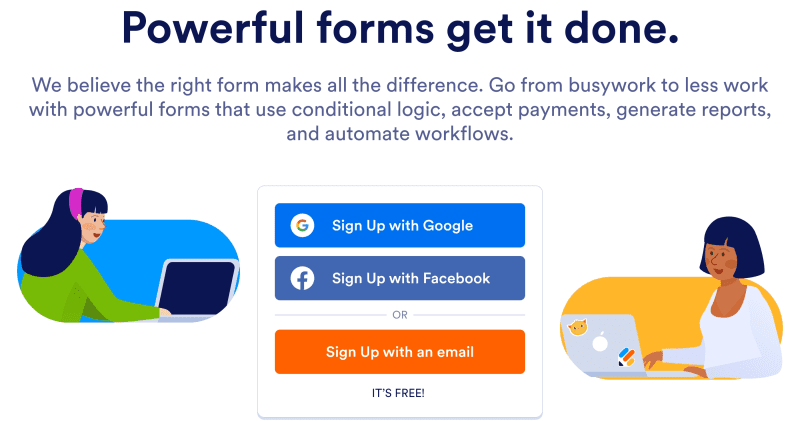
Jotform Pros
Collect e-commerce payments
Track and manage forms offline with the dedicated mobile app
Offers translation in 130+ languages
Access learning resources such as how-to articles and webinars
Jotform Cons
CSS editor has limited functions
Limited customization options
Jotform Pricing
| Plan | Key Features | Pricing |
|---|---|---|
| Starter | Form templates, 100 monthly submissions, payment integrations, and 100MB storage space | Free |
| Bronze | Form importer, form sharing, group approvals, email notifications, and accept payments | $34/month |
| Silver | Interactive forms, brand kit, visual reporting, 24/7 customer support, form analytics, and email notifications | $39/month |
| Gold | Form analytics, advanced logic jumps, custom CSS support, HIPAA compliance features, CRM integrations, and integration with 30+ popular payment gateways | $99/month |
| Enterprise | Unlimited forms, custom domains, Single Sign-On, white labeling, GDPR and HIPAA compliance features, API access, and custom branding | Contact for quote |
5. Cognito Form
Best for Complex Logic and Payment Integration
Cognito Forms is a free online form builder with advanced capabilities for developers and simplicity for beginners. It offers over 200 pre-made form templates that are categorized for different industries and business needs, making it easy to find a suitable template for various purposes, such as contact forms, registrations, feedback, and surveys.
Cognito Forms allows for customized data collection, including measurement parameters and file attachments, so you can gather the specific information you need from respondents. It also streamlines and automates multi-step approval processes within forms, ensuring necessary approvals are obtained before proceeding with tasks or projects.
Cognito Forms integration with Google Analytics enables you to add Meta Pixel ID or Google Tag Manager code snippets to forms and gain real-time insights into your form performance, such as conversion rates from the Google Analytics dashboard.
Cognito Forms offers integrations with popular payment gateways like Stripe, Square, and PayPal to securely accept payments directly through forms.
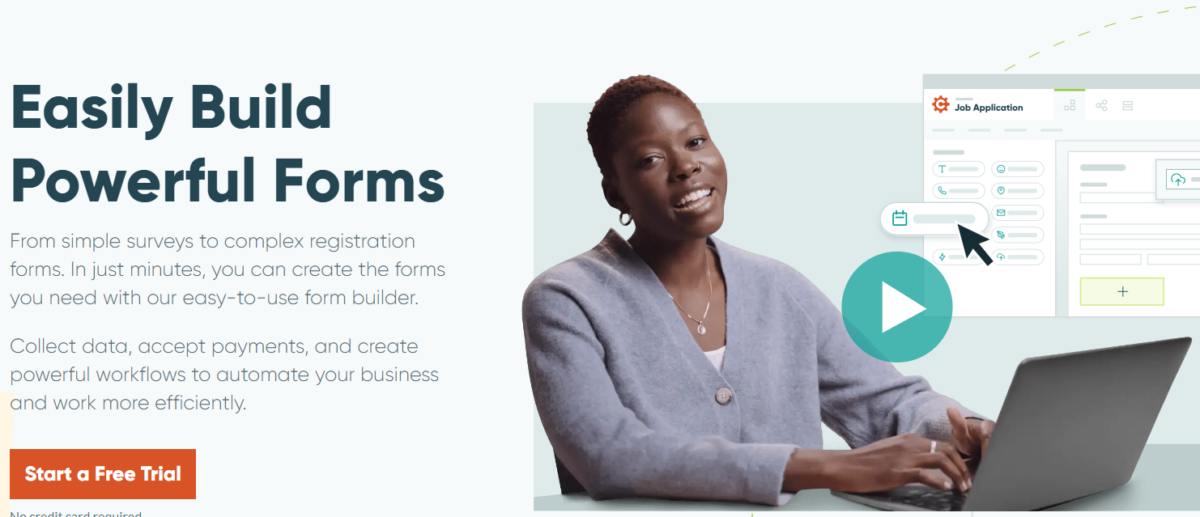
Cognito Forms Pros
Create unlimited forms with the free plan
Easily create responsive forms
Offers automated workflows
Cognito Forms Cons
Only paid plans offer access to e-sign, automation, and data management features.
Users may encounter occasional bugs and glitches during their experience.
Cognito Forms Pricing
| Plan | Key Features | Pricing |
|---|---|---|
| Individual | Unlimited forms, 500 entries/month, 100 MB storage, accept payments | Free |
| Pro | Interactive forms, form analytics, visual reporting, email notifications, and authenticated forms | $15/month |
| Team | Form analytics, advanced logic jumps, custom CSS support, payment acceptance using Paypal, and 24/7 customer support | $35/month |
| Enterprise | Custom branding, Single Sign-On, 2FA, brand kits, GDPR and HIPAA compliance features, API access, and advanced analytics | $99/month |
6. Zoho Forms
Best for CRM Integration in the Zoho Ecosystem
Zoho Forms is a form builder app that works well in scenarios involving extensive online surveys. We find the tool reliable and capable of handling large data sets. It offers real-time alerts for form submissions via email, SMS, or Microsoft Teams.
Zoho Forms has a drag-and-drop form builder with over 30 different field types, making it easy to create customizable forms for collecting information. It also offers over 50 responsive form templates that adjust to different screen types and browsers, ensuring forms look and function properly.
Zoho Forms offers powerful automation features such as Approval workflow, Data routing, and integrations with other apps to streamline workflow and automate repetitive tasks for efficient and accurate form submission processing.
Zoho Forms are easily scalable to meet the demands of all business sizes. Its intuitive, no-code online form builder uncomplicates the form-building process for novice users. It offers a mobile app for both Android and iOS users.
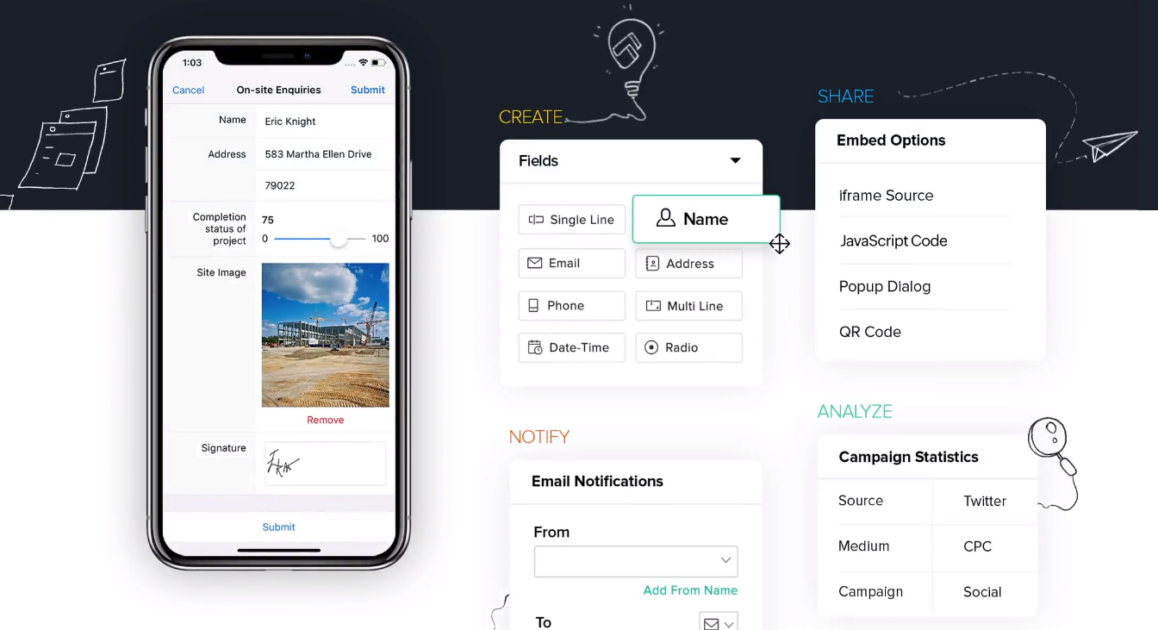
Zoho Forms Pros
Offer multi-page forms
Ideal for collecting and managing large datasets
Comes with a dedicated, feature-rich mobile app that functions offline
Zoho Forms Cons
Customize design options for advanced users are lacking in Zoho Forms
Limited integration with software and services outside the Zoho product suite
Zoho Forms Pricing
| Plan | Key Features | Pricing |
|---|---|---|
| Free forever | Basic form analytics, Zoho marketing automation, CAPTCHA, and UTM tracking | Free |
| Basic | SSL encryption, customizable filters, field validations, email notifications, 30+ field types, and form audit | $10/month |
| Standard | Task management, form audit, Google reCAPTCHA v2, form language translation, custom messages, and CRM forms | $25/month |
| professional | Custom domain, secure 10+ payment gateways, task management, CRM forms, custom themes, and custom CSS | $50/month |
| Premium | GDPR compliance features, custom branding, record audit, brand kits, report scheduler, and auto-trash submissions | $90/month |
7. Wufoo
Best for Quick Forms with a Variety of Templates
Wufoo is a cloud-based software that creates online forms for various purposes, such as user registration, surveys, and payments. The platform is trusted by over three million users, including top brands like Disney, Sony, and Amazon.
Wufoo offers stylish, modern templates powered by Wix for easily customizable forms that match your brand or website’s look.
Wufoo provides easy-to-use design tools and integrates with over 2,300 third-party apps, including payment apps like PayPal and Stripe, allowing users to collect payments through their forms.
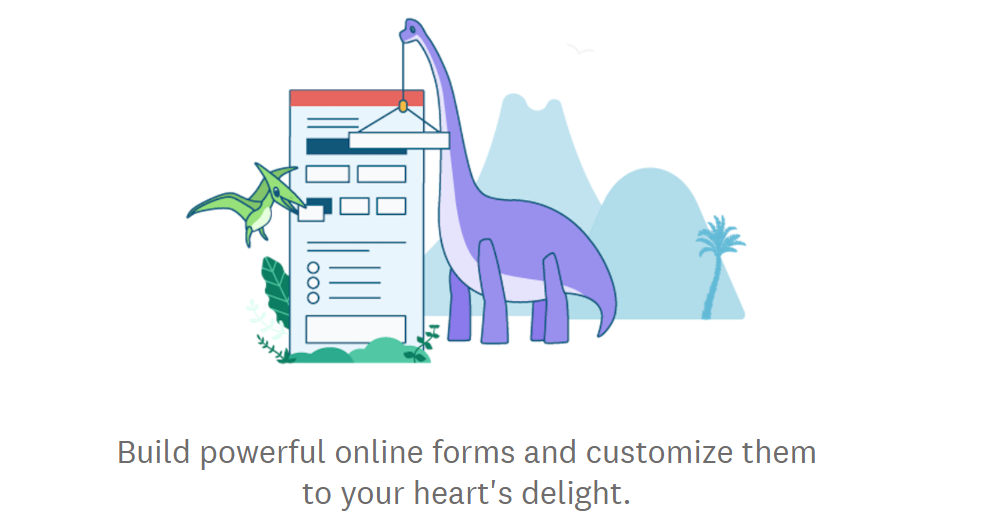
Wufoo Pros
Integrates well with most existing apps for seamless usage
Offers customization options for both beginners and advanced users
Prevents spam in your forms with Wufoo’s CAPTCHA integrations
Wufoo Cons
The steep learning curve for new user
Limited customization in the free plan
Wufoo Pricing
| Plan | Key Features | Pricing |
|---|---|---|
| Free | Build primary 5 forms, 100 API requests, and email support | Free |
| Starter | Customize branding, send confirmation email, automate workflows, accept payments, and field validation. | $14.08/month |
| Professional | Accept payments, unlimited forms, real-time notifications, smart CAPTCHA, and 400+ ready-to-go templates | $29.08/month |
| Advanced | Automated workflows, custom confirmation page, form data export, Google Analytics, 24/7 customer support, and custom reports | $74.08/month |
| Ultimate | 100k API requests, priority support, custom branding, 20 GB of storage, REST API, advanced analytics & reporting, and custom responses | $183.25/month |
8. 123FormBuilder
Best for Versatile Form Building and Data Collection
123FormBuilder is a web form builder software with a no-code, drag-and-drop form editor that offers 2000+ form templates for various use cases like event registration, order forms, application forms, and survey forms.
123FormBuilder supports integration with over 4000+ digital tools, such as Wix, Shopify, Dropbox, Marketo, and HubSpot, allowing organizations to automate workflows.
123FormBuilder allows users to seamlessly collect payments by integrating with over 10 payment service providers, including PayPal, Stripe, and Square, making it easy for businesses to sell products or services online.
123FormBuilder offers form branching and conditional logic functions, allowing users to create customizable forms that adjust based on responses. This helps streamline the form-filling process and ensures relevant information is gathered.
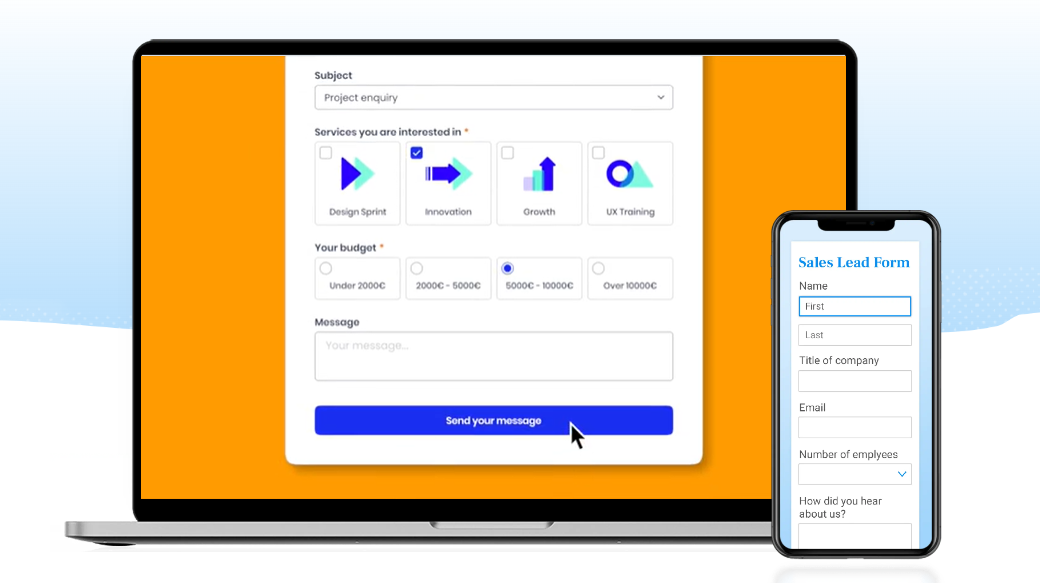
123FormBuilder Pros
Offers user-friendly UI/UX design and regular updates for enhancements
Provides a wide variety of form types and industry-specific templates
123FormBuilder Cons
Limited number of form creation with the free plan
Limited support options
123FormBuilder Pricing
| Plan | Key Features | Pricing |
|---|---|---|
| Basic | Submissions tracking, CSS styling, Google Analytics tracking, and advanced form editor | Free |
| Gold | Custom email notifications, advanced theme editing, conditional logic, custom reports, and multi-page forms | $32/month |
| Platinum | Integration with 15+ payment gateways, SMTP, multi-language forms, and custom forms | $39/month |
| Diamond | Multi-user collaboration, data encryption, GDPR compliance, advanced form analytics, field insights and digital signature | $79/month |
| Enterprise | Custom form domain, dedicated account manager, Single-Sign-On (SSO), virtual database manager, SLA & data insurance, and HIPAA compliance features | $225/month |
9. Microsoft Forms
Best for Office 365 Users with Real-Time Collaboration
Microsoft Forms is a web-based form builder software that allows users to create surveys, quizzes, polls, and questionnaires quickly. It is part of the Microsoft 365 suite and integrates well with other Microsoft applications like Excel, SharePoint, and OneDrive for easy data storage, sharing, and collaboration.
Microsoft Forms is a user-friendly tool for creating forms without coding or design skills. Its drag-and-drop form builder makes it easy to create custom forms. It offers a variety of question types and features, such as multiple-choice, text entry, ratings, and logic branching, to help users collect data in the format that suits their needs.
Microsoft Forms is a user-friendly tool that allows for the creation of surveys, quizzes, polls, and registration forms without the need for coding or design skills. Its drag-and-drop form builder makes it easy to create custom forms.
Microsoft Forms has instant data visualization capabilities, allowing users to analyze trends and insights in real-time using graphs and charts. This feature helps make data-driven decisions and track progress over time.
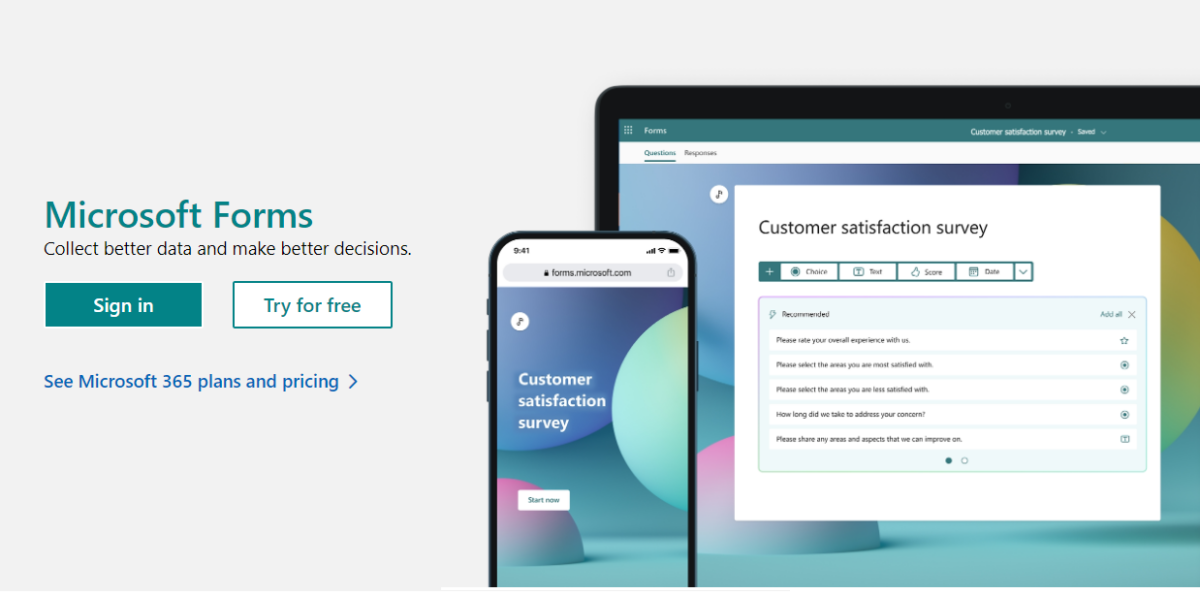
Microsoft Forms Pros
Offer integration with the Microsoft 365 suite
Provides real-time responses
Microsoft Forms Cons
Limited integration options with apps outside the Microsoft 365 suite
Limited customization options
Microsoft Forms Pricing
| Plan | Key Features | Pricing |
|---|---|---|
| Free | Basic features, limited submissions/storage | Free |
| Microsoft 365 Personal | Unlimited submissions, 1 TB storage, In-app collaboration, and 100+pre-build form templates | $6.99/month |
| Microsoft 365 Family | Advanced security, 6 TB storage, support upto 6 users, ad-free email, custom message, priority support, and In-app collaboration | $9.99/month |
10. Formsite
Best for Secure Data Handling and Complex Form Structures
Formsite online form builder software helps in creating highly responsive, professional-looking forms. It’s trusted by well-known brands and organizations, including eBay, FedEx, Dell, and institutions like Harvard University.
Formsite is popular for securely handling large sets of responses and complex form structures. It offers pre-built templates and a variety of item types for customization.
Formsite offers easy form styling options that allow users to customize fonts and colors to match their brand guidelines, creating professional-looking forms that make a great impression on customers.
Formsite’s role-based access management system allows team members to share and collaborate on forms efficiently by assigning different levels of access permissions.
Formsite offers easy payment processing through forms and integrations with various payment services, such as PayPal, Braintree, Authorize.net, and Stripe, allowing businesses to collect payments from customers securely.
Formsite provides integrations with popular third-party tools such as Mailchimp, Slack, Zapier, Constant Contact, DocuSign, Dropbox, and Google Workspace apps to streamline workflow and increase productivity by easily connecting forms to other tools.
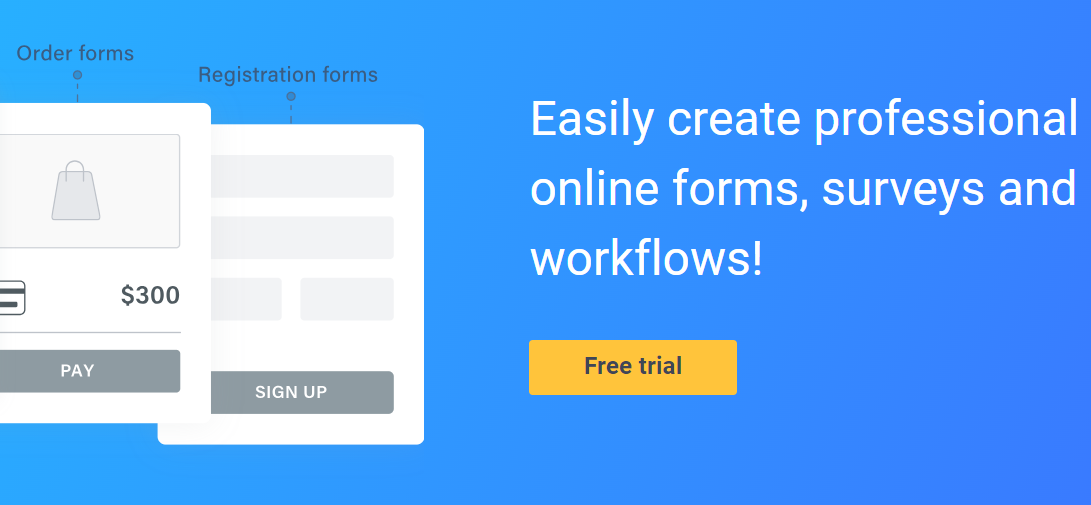
Formsite Pros
Offers customized themes, colors, and layout options available to the user.
Secures data with SSL encryption, CAPTCHA, password protection, and data encryption.
Formsite Cons
No free version is available
Limited features and customization in the basic plan
Formsite Pricing
| Plan | Key Features | Pricing |
|---|---|---|
| Deluxe | 500 MB file space, hidden field, reCAPTCHA, and multiple page forms | $21/month |
| Pro 1 | Automatic form spam prevention, reCAPTCHA, conditional branching, and eSignature | $34/month |
| Pro 2 | Customizable email messages, email notifications, Zapier integration, customizable URL, page fall-off statistics, and data encryption | $59/month |
| Pro 3 | Unlimited workflows, API access, PDF results, custom results docs, multiple page forms, data encryption, and custom branding | $84/month |
| Enterprise | Automated workflows, data retention policy, HIPAA features, 10 GB file space, custom branding, advanced analytics and API access | $209/month |
Form Builders Comparison
| Form Builders | Key Features | Integrations | Pricing (Monthly on annual plan) |
|---|---|---|---|
| Google Forms | Real-time alerts and updates via Gmail and data collection in GSheet. | Integrates with Google Workspace and Zapier | Freemium, $12/month |
| Tally | Advanced customization options with 50+ pre-built form templates | Integrates with platforms like Notion, Zapier, Airtable, Make, and more | Freemium, $29/month |
| Typeform | AI assistant to help build forms and automate workflow with 3000+ ready-made templates | Integrations to popular ESPs, CRMs, and more essential apps | Freemium, $25/month |
| Jotform | Extensive collection of pre-built form templates and free form themes | Integrates with HubSpot, GSheets, Slack, and 150+ other tools | Freemium, $34/month |
| Cognito Forms | Easy to configure data collection touchpoints with no-code interface | Integrates with WordPress, Google Analytics, Microsoft Power Automate, and more | Freemium, $15/month |
| Zoho Forms | Integrates with apps in Zoho ecosystem as well as third-party tools like Zapier | Integrates with Zoho app ecosystem, Office 365, and Zapier to connect with 1000+ other apps. | Freemium, $10/month |
| Wufoo | Extensive range of stylish and modern form templates | Integrates with 2,300+ third-party apps, PayPal, Stripe, and Authorize.Net | Freemium, $14.08/month |
| 123FormBuilder | No-code form building tools and offers 2000+ ready-made, mobile-optimized form templates | Supports integration to 4000+ digital tools and 10+ payment service providers | Freemium, $32/month |
| Microsoft Forms | Instant analytics feature with real-time responses | Advanced analytics and seamless integration with apps in Microsoft 365 | Freemium, $6.99/month |
| Formsite | Well-versed integrations with popular ESPs, CRMs, and Dialer apps | Integrates with Mailchimp, Zapier, DocuSign, and 5000+ other apps | Freemium, $21/month |
Bonus: Popular WordPress Form Builders
The popular WordPress form builders include Gravity Forms, WPForms, and Formaloo.
Gravity Forms is a feature-rich form builder that offers advanced functionality such as conditional logic and file uploads.
Formaloo is a powerful form builder offering CRM capabilities, making it an excellent option for businesses looking to track and manage leads more effectively.
Key Features to Look for in a Form Builder
When selecting a form builder, consider these key features:
- Intuitive interface: Choose an online form builder with drag-and-drop functions and easy navigation for effortless form creation.
- No-code functionality: To create online forms without coding skills, it’s best to use a form builder tool with no-code functionality.
- Templates: Choose a tool that offers pre-built form templates for surveys, signup forms, registration, feedback, and other use cases.
- Customization options: An ideal form builder must have customization options to modify and adapt templates or custom-created forms to align with your branding.
- Mobile-optimized forms: Ensure the form builder provides mobile-optimized forms, as a significant portion of web traffic comes from mobile devices.
- Easy to share and export: Choose a tool that allows easy data sharing and exporting with your existing CRMs and data storage units.
- Analytics: Choose a form builder that provides analytics and custom reporting features to monitor your forms’ performance.
Apart from these, there are other non-negotiable factors like pricing and user reviews you should consider before making a choice.
Best Practices for Form Design
To create form designs that increase conversions, consider the following practices.
- Be simple and straightforward: Try to be specific with your questions and avoid adding unnecessary fields.
- Work on customer feedback: Proactively collect and work on customer feedback. Use customer feedback tools to collect, manage, and analyze feedback in a centralized manner
- Use one-column forms: Opt for single-column forms as they are easier for users to understand and complete.
- Use inline form field validation: Implement inline form field validation to catch errors and ensure accurate information is provided.
- Use progress bars for lengthy forms: Incorporate progress bars for longer forms to keep respondents informed of their progress and encourage completion. Google Forms offers easy settings for adding progress bars with a simple click.
My Opinion: The Best Free Form Builder
Google Forms is the right choice if you’re looking for something simple and intuitive that syncs with your Google products. Jotform and Typeform are better for dynamic forms, while Microsoft Forms works well for Microsoft 365 users.
For WordPress website owners, you can go for

